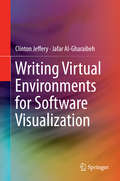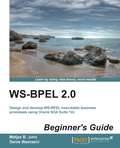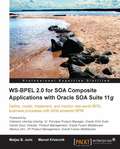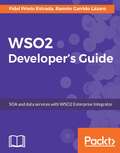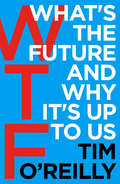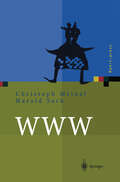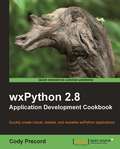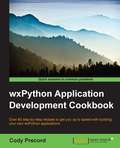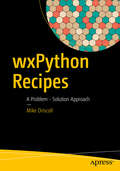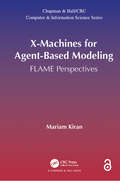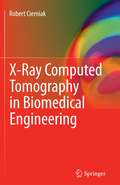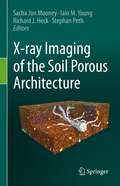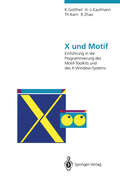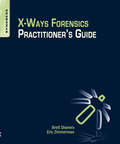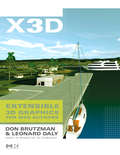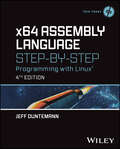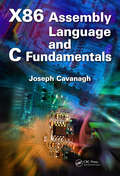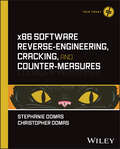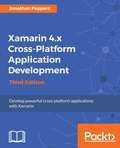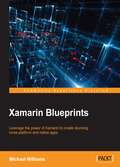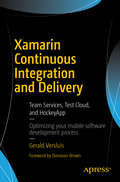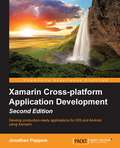- Table View
- List View
Writing Virtual Environments for Software Visualization
by Clinton Jeffery Jafar Al-GharaibehWriting Virtual Environments for Software Visualization book describes the software for a networked, 3D multi-user virtual environment that allows users to create and share remotely visualizations of program behavior. Collaborative virtual environments such as World of Warcraft or Second Life are a popular way to share interactive internet experiences, but they are complex and difficult to create. Software visualization is an area that may enable important advances in our ability to understand and reduce the costs of maintaining software. Applying the former technology to this problem area will be valuable to distributed and multi-institutional software development and educational users. The author covers the major features of collaborative virtual environments and how to program them in a very high level language. The book also examines the application of popular game-like software technologies.
WS-BPEL 2.0 Beginner's Guide
by Matjaz B. Juric Denis WeerasiriIf you are a software architect, a designer, a software developer, an SOA and BPM architect, a project manager, or a business process analyst who is responsible for the design and development of business processes, composite applications, and BPM/SOA solutions, then this book is for you. You should have a clear grasp of general SOA concepts including business processes and web services, but no prior knowledge of the BPEL language is required.
WS-BPEL 2.0 for SOA Composite Applications with Oracle SOA Suite 11g
by Matjaz B. Juric Marcel KrizevnikThis book is a comprehensive guide that shows developers how to design and develop business processes in BPEL efficiently. Throughout the book, the authors discuss important concepts and show real-world examples covering Oracle SOA Suite 11g and related products. This book is aimed at SOA architects and developers involved in the design, implementation, and integration of composite applications and end-to-end business processes. The book provides comprehensive coverage of WS-BPEL 2.0 for implementing business processes and developing SCA composite application, dealing with the issues of composition, orchestration, transactions, coordination, and security. This book uses Oracle SOA Suite 11g and related Oracle products. To follow this book you need to have basic knowledge of XML, web services, and Java EE.
WSO2 Developer's Guide: SOA and data services with WSO2 Enterprise Integrator
by Fidel Prieto Estrada Ramon Garrido LazaroWSO2 Made Simple – dive deep into the core concepts of WSO2 to overcome the challenges faced while using the Enterprise Integrator About This Book • Design, create, and publish services in the WSO2 technology • Integrate the WSO2 Enterprise Integrator with other components and servers • Log and test deployed services Who This Book Is For If you are a Java solutions architect or developer and are keen to understand how to build enterprise applications with WSO2, this book is for you. No prior knowledge of WSO2 is expected. What You Will Learn • Configure WSO2 Enterprise Integrator server in a production environment • Create SOAP Proxies and REST APIs • Interact with WSO2 Message Broker • Write services using the new language: Ballerina • Schedule automatic tasks for the services you create • Manage log messages depending on the log level of the system • Integrate with social networks such as Twitter, Facebook, Instagram, and Yammer • Test SOAP Services using the Tryit feature and SoapUI tool • Work with Quality of Services In Detail WSO2 Enterprise Integrator brings together the most powerful servers provided by the WSO2 company for your SOA infrastructure. As an Enterprise Service Bus (ESB), WSO2 Enterprise Integrator provides greater flexibility and agility to meet growing enterprise demands, whereas, as a Data Services Server (DSS), it provides an easy-to-use platform for integrating data stores, creating composite views across different data sources, and hosting data services. Using real-world scenarios, this book helps you build a solid foundation in developing enterprise applications with powerful data integration capabilities using the WSO2 servers. The book gets you started by brushing up your knowledge about SOA architecture and how it can be implemented through WSO2. It will help build your expertise with the core concepts of ESB such as building proxies, sequences, endpoints, and how to work with these in WSO2. Going further, you will also get well-acquainted with DSS data service concepts such as configuring data services, tasks, events, testing, and much more. The book will also cover API management techniques. Along with ESB and DSS, you will also learn about business process servers, the rules server and other components that together provide the control and robustness your enterprise applications will need. With practical use cases, the book covers typical daily scenarios you will come across while using these servers to give you hands-on experience. Style and approach The book is a complete guide and helps you get the right start—from understanding SOA architectures to getting valuable experience with two important integration servers such as ESB and DSS. It will include some real-world practical scenarios to help you master the best practices followed right across the industry and overcome the challenges you're likely to face on a daily basis.
WTF?: What's the Future and Why It's Up to Us
by Tim O'Reilly‘The man who can really make a whole industry happen.’ Eric Schmidt, Executive Chairman of Google‘A punchy and provocative book . . . WTF? is an insightful and heartfelt plea, daring us to reimagine a better economy and society.’ Financial TimesRenowned as ‘the Oracle of Silicon Valley’, Tim O’Reilly has spent three decades exploring the world-transforming power of information technology. Now, the leading thinker of the internet age turns his eye to the future – and asks the questions that will frame the next stage of the digital revolution:· Will increased automation destroy jobs or create new opportunities?· What will the company of tomorrow look like?· Is a world dominated by algorithms to be welcomed or feared?· How can we ensure that technology serves people, rather than the other way around?· How can we all become better at mapping future trends?Tim O’Reilly’s insights create an authoritative, compelling and often surprising portrait of the world we will soon inhabit, highlighting both the many pitfalls and the enormous opportunities that lie ahead.‘Tim O’Reilly has been at the cutting edge of the internet since it went commercial.’ New York Times‘O’Reilly’s ability to quickly identify nascent trends is unparalleled.’ Wired
WWW: Kommunikation, Internetworking, Web-Technologien (Xpert.press)
by Christoph Meinel Harald SackDieses Handbuch bietet für alle Nutzer und Entwickler des World Wide Web einen fundierten Einblick in dessen Aufbau und Funktionsweise. Die Autoren stellen die Internet-Technologie ausführlich dar und geben einen umfassenden Überblick über die relevanten Teilbereiche des WWW. Neben den allgemeinen theoretischen und praktischen Grundlagen der Netzwerktechnik und einer Darstellung der TCP/IP-Protokolle werden auch die vielfältigen Medientypen und deren Kodierung im WWW erläutert. Darauf aufbauend wird auf spezielle Web-Technologien im WWW wie HTTP, HTML, CSS, XML/XSL aber auch Skriptsprachen und CGI-Programmierung eingegangen. Dabei werden die allgemeinverständlich angelegten Kapitel punktuell durch relevante Schwerpunktthemen technischer Natur ergänzt und vertieft. Zahlreiche Abbildungen sowie Index und Glossar zu jedem Kapitel erhöhen den praktischen Nutzen des Handbuchs.
wxPython 2.8 Application Development Cookbook
by Cody PrecordWritten in cookbook style, this book offers learning and techniques through recipes. It contains step-by-step instructions for developers who want to build feature-rich desktop applications in wxPython. The book is designed in such a way that you can refer to things chapter by chapter, and read them in no particular order. This book is written for python programmers wanting to develop GUI applications. Basic knowledge of Python is required.
wxPython Application Development Cookbook
by Cody PrecordOver 80 step-by-step recipes to get you up to speed with building your own wxPython applications About This Book • This book empowers you to create rich cross-platform graphical user interfaces using Python • It helps you develop applications that can be deployed on Windows, OSX, and Linux • The recipes in the book involve real-world applications, giving you a first-hand experience of the practical scenarios Who This Book Is For For those who are familiar with programming in Python and want to start building applications with graphical user interfaces, this book will get you up and running quickly. A basic understanding of the Python programming language and object-oriented concepts are all that is needed. What You Will Learn • Create full featured user interfaces • Design and develop custom controls • Deploy and distribute wxPython applications to Windows, Macintosh OS X, Linux, and other UNIX-like environments • Handle and respond to application events • Manage and display data using grids • Interact with web services from your GUI • Use Paint events to draw custom displays • Support the display of user interfaces in multiple languages In Detail wxPython is a GUI toolkit for the Python programming language built on top of the cross-platform wxWidgets GUI libraries. wxPython provides a powerful set of tools that allow you to quickly and efficiently building applications that can run on a variety of different platforms. Since wxWidgets provides a wrapper around each platform's native GUI toolkit, the applications built with wxPython will have a native look and feel wherever they are deployed. This book will provide you with the skills to build highly functional and native looking user interfaces for Python applications on multiple operating system environments. By working through the recipes, you will gain insights into and exposure to creating applications using wxPython. With a wide range of topics covered in the book, there are recipes to get the most basic of beginners started in GUI programming as well as tips to help experienced users get more out of their applications. The recipes will take you from the most basic application constructs all the way through to the deployment of complete applications. Style and approach This book is a collection of step-by-step recipes that introduce the various components and concepts of wxPython in a conversational and easy-to-follow way. Each recipe contains coded examples along with detailed explanations about the key points of each topic. Each topic is designed to introduce and show you how to use a single feature from the wxPython library.
wxPython Recipes: A Problem - Solution Approach
by Mike DriscollQuickly discover solutions to common problems, learn best practices, and understand everything wxPython has to offer. This book is for anyone wanting to learn more about how to use the wxPython desktop GUI toolkit. It assumes some prior knowledge of Python and a general understanding of wxPython or GUI development, and contains more than 50 recipes covering various tasks and aspects of the toolkit.wxPython Recipes guides you step by step. The book takes you through how to create user interfaces in Python, including adding widgets, changing background images, manipulating dialogs, managing data, and much more. Examples target both Python 2.x and 3.x, and cover both wxPython 3.0 and Phoenix, offering a complete collection of ideas to improve your GUI development.What You'll LearnWork with UI elements such as widgets, buttons, images, boxes, and moreHandle data in files and notebooksImplement XML and using XML resources (XRC)Customize the behavior of panels and objects Who This Book Is ForPeople who are already familiar with the Python programming language and also have a basic understanding of wxPython. Readers who understand event loops and the basics of creating user interfaces with another Python UI toolkit, such as Tkinter or PyQt.
X-Machines for Agent-Based Modeling: FLAME Perspectives (Chapman & Hall/CRC Computer and Information Science Series)
by Mariam KiranFrom the Foreword: "This book exemplifies one of the most successful approaches to modeling and simulating [the] new generation of complex systems. FLAME was designed to make the building of large scale complex systems models straightforward and the simulation code that it generates is highly efficient and can be run on any modern technology. FLAME was the first such platform that ran efficiently on high performance parallel computers and a version for GPU technology is also available. At its heart, and the reason why it is so efficient and robust, is the use of a powerful computational model ‘Communicating X-machines’ which is general enough to cope with most types of modelling problems. As well as being increasingly important in academic research, FLAME is now being applied in industry in many different application areas. This book describes the basics of FLAME and is illustrated with numerous examples."—Professor Mike Holcombe, University of Sheffield, UK Agent-based models have shown applications in various fields such as biology, economics, and social science. Over the years, multiple agent-based modeling frameworks have been produced, allowing experts with non-computing background to easily write and simulate their models. However, most of these models are limited by the capability of the framework, the time it takes for a simulation to finish, or how to handle the massive amounts of data produced. FLAME (Flexible Large-scale Agent-based Modeling Environment) was produced and developed through the years to address these issues. This book contains a comprehensive summary of the field, covers the basics of FLAME, and shows how concepts of X-machines, can be stretched across multiple fields to produce agent models. It has been written with several audiences in mind. First, it is organized as a collection of models, with detailed descriptions of how models can be designed, especially for beginners. A number of theoretical aspects of software engineering and how they relate to agent-based models are discussed for students interested in software engineering and parallel computing. Finally, it is intended as a guide to developers from biology, economics, and social science, who want to explore how to write agent-based models for their research area. By working through the model examples provided, anyone should be able to design and build agent-based models and deploy them. With FLAME, they can easily increase the agent number and run models on parallel computers, in order to save on simulation complexity and waiting time for results. Because the field is so large and active, the book does not aim to cover all aspects of agent-based modeling and its research challenges. The models are presented to show researchers how they can build complex agent functions for their models. The book demonstrates the advantage of using agent-based models in simulation experiments, providing a case to move away from differential equations and build more reliable, close to real, models. The Open Access version of this book, available at https://doi.org/10.1201/9781315370729, has been made available under a Creative Commons Attribution-Non Commercial-No Derivatives 4.0 license.
X-Machines for Agent-Based Modeling: FLAME Perspectives (Chapman & Hall/CRC Computer and Information Science Series)
by Mariam KiranFrom the Foreword: "This book exemplifies one of the most successful approaches to modeling and simulating [the] new generation of complex systems. FLAME was designed to make the building of large scale complex systems models straightforward and the simulation code that it generates is highly efficient and can be run on any modern technology. FLAME was the first such platform that ran efficiently on high performance parallel computers and a version for GPU technology is also available. At its heart, and the reason why it is so efficient and robust, is the use of a powerful computational model ‘Communicating X-machines’ which is general enough to cope with most types of modelling problems. As well as being increasingly important in academic research, FLAME is now being applied in industry in many different application areas. This book describes the basics of FLAME and is illustrated with numerous examples."—Professor Mike Holcombe, University of Sheffield, UK Agent-based models have shown applications in various fields such as biology, economics, and social science. Over the years, multiple agent-based modeling frameworks have been produced, allowing experts with non-computing background to easily write and simulate their models. However, most of these models are limited by the capability of the framework, the time it takes for a simulation to finish, or how to handle the massive amounts of data produced. FLAME (Flexible Large-scale Agent-based Modeling Environment) was produced and developed through the years to address these issues. This book contains a comprehensive summary of the field, covers the basics of FLAME, and shows how concepts of X-machines, can be stretched across multiple fields to produce agent models. It has been written with several audiences in mind. First, it is organized as a collection of models, with detailed descriptions of how models can be designed, especially for beginners. A number of theoretical aspects of software engineering and how they relate to agent-based models are discussed for students interested in software engineering and parallel computing. Finally, it is intended as a guide to developers from biology, economics, and social science, who want to explore how to write agent-based models for their research area. By working through the model examples provided, anyone should be able to design and build agent-based models and deploy them. With FLAME, they can easily increase the agent number and run models on parallel computers, in order to save on simulation complexity and waiting time for results. Because the field is so large and active, the book does not aim to cover all aspects of agent-based modeling and its research challenges. The models are presented to show researchers how they can build complex agent functions for their models. The book demonstrates the advantage of using agent-based models in simulation experiments, providing a case to move away from differential equations and build more reliable, close to real, models. The Open Access version of this book, available at https://doi.org/10.1201/9781315370729, has been made available under a Creative Commons Attribution-Non Commercial-No Derivatives 4.0 license.
X-Ray Computed Tomography in Biomedical Engineering
by Robert CierniakComputed Tomography gives a detailed overview of various aspects of computed tomography. It discusses X-ray CT tomography from a historical point of view, the design and physical operating principles of computed tomography apparatus, the algorithms of image reconstruction and the quality assessment criteria of tomography scanners. Algorithms of image reconstruction from projections, a crucial problem in medical imaging, are considered in depth. The author gives descriptions of the reconstruction methods related to tomography scanners with a parallel X-ray beam, trough solutions with fan-shaped beam and successive modifications of spiral scanners. Computed Tomography contains a dedicated chapter for those readers who are interested in computer simulations based on studies of reconstruction algorithms. The information included in this chapter will enable readers to create a simulation environment in which virtual tomography projections can be obtained in all basic projection systems. This monograph is a valuable study on computed tomography that will be of interest to advanced students and researchers in the fields of biomedical engineering, medical electronics, computer science and medicine.
X-ray Imaging of the Soil Porous Architecture
by Sacha Jon Mooney Iain M. Young Richard J. Heck Stephan PethThe advent of X-ray Computed Tomography (CT) as a tool for the soil sciences almost 40 years ago has revolutionised the field. Soil is the fragile, thin layer of material that exists above earth’s geological substrates upon which so much of life on earth depends. However a major limitation to our understanding of how soils behave and function is due to its complex, opaque structure that hinders our ability to assess its porous architecture without disturbance. X-ray imagery has facilitated the ability to truly observe soil as it exists in three dimensions and across contrasting spatial and temporal scales in the field in an undisturbed fashion. This book gives a comprehensive overview of the “state of the art” in a variety of application areas where this type of imaging is used, including soil water physics and hydrology, agronomic management of soils, and soil-plant-microbe interactions. It provides the necessary details for entry level readers in the crucial areas of sample preparation, scanner optimisation and image processing and analysis. Drawing on experts across the globe, from both academia and industry, the book covers the necessary “dos and don’ts”, but also offers insights into the future of both technology and science. The wider application of the book is provided by dedicated chapters on how the data from such imagery can be incorporated into models and how the technology can be interfaced with other relevant technical applications. The book ends with a future outlook from the four editors, each of whom has over 20 years of experience in the application of X-ray CT to soil science.
X und Motif: Einführung in die Programmierung des Motif-Toolkits und des X-Window-Systems
by Klaus Gottheil Hermann-Josef Kaufmann Thomas Kern Rui ZhaoX-Ways Forensics Practitioner’s Guide
by Eric Zimmerman Brett ShaversThe X-Ways Forensics Practitioner's Guide is more than a manual-it's a complete reference guide to the full use of one of the most powerful forensic applications available, software that is used by a wide array of law enforcement agencies and private forensic examiners on a daily basis. In the X-Ways Forensics Practitioner's Guide, the authors provide you with complete coverage of this powerful tool, walking you through configuration and X-Ways fundamentals, and then moving through case flow, creating and importing hash databases, digging into OS artifacts, and conducting searches. With X-Ways Forensics Practitioner's Guide, you will be able to use X-Ways Forensics to its fullest potential without any additional training. The book takes you from installation to the most advanced features of the software. Once you are familiar with the basic components of X-Ways, the authors demonstrate never-before-documented features using real life examples and information on how to present investigation results. The book culminates with chapters on reporting, triage and preview methods, as well as electronic discovery and cool X-Ways apps.Provides detailed explanations of the complete forensic investigation processe using X-Ways Forensics.Goes beyond the basics: hands-on case demonstrations of never-before-documented features of X-Ways.Provides the best resource of hands-on information to use X-Ways Forensics.
X3D: Extensible 3D Graphics for Web Authors (The Morgan Kaufmann Series in Computer Graphics)
by Don Brutzman Leonard DalyIn the early days of the Web a need was recognized for a language to display 3D objects through a browser. An HTML-like language, VRML, was proposed in 1994 and became the standard for describing interactive 3D objects and worlds on the Web. 3D Web courses were started, several best-selling books were published, and VRML continues to be used today. However VRML, because it was based on HTML, is a stodgy language that is not easy to incorporate with other applications and has been difficult to add features to. Meanwhile, applications for interactive 3D graphics have been exploding in areas such as medicine, science, industry, and entertainment. There is a strong need for a set of modern Web-based technologies, applied within a standard extensible framework, to enable a new generation of modeling & simulation applications to emerge, develop, and interoperate. X3D is the next generation open standard for 3D on the web. It is the result of several years of development by the Web 3D Consortium's X3D Task Group. Instead of a large monolithic specification (like VRML), which requires full adoption for compliance, X3D is a component-based architecture that can support applications ranging from a simple non-interactive animation to the latest streaming or rendering applications. X3D replaces VRML, but also provides compatibility with existing VRML content and browsers. Don Brutzman organized the first symposium on VRML and is playing a similar role with X3D; he is a founding member of the consortium. Len Daly is a professional member of the consortium and both Len and Don have been involved with the development of the standard from the start.The first book on the new way to present interactive 3D content over the Web, written by two of the designers of the standardPlentiful illustrations and screen shots in the full color textCompanion website with extensive content, including the X3D specification, sample code and applications, content creation tools, and demos of compatible Web browsers
x64 Assembly Language Step-by-Step: Programming with Linux (Tech Today)
by Jeff DuntemannThe long-awaited x64 edition of the bestselling introduction to Intel assembly language In the newly revised fourth edition of x64 Assembly Language Step-by-Step: Programming with Linux, author Jeff Duntemann delivers an extensively rewritten introduction to assembly language with a strong focus on 64-bit long-mode Linux assembler. The book offers a lighthearted, robust, and accessible approach to a challenging technical discipline, giving you a step-by-step path to learning assembly code that’s engaging and easy to read. x64 Assembly Language Step-by-Step makes quick work of programmable computing basics, the concepts of binary and hexadecimal number systems, the Intel x86/x64 computer architecture, and the process of Linux software development to dive deep into the x64 instruction set, memory addressing, procedures, macros, and interface to the C-language code libraries on which Linux is built. You’ll also find: A set of free and open-source development and debugging tools you can download and put to use immediately Numerous examples woven throughout the book to illustrate the practical implementation of the ideas discussed within Practical tips on software design, coding, testing, and debuggingA one-stop resource for aspiring and practicing Intel assembly programmers, the latest edition of this celebrated text provides readers with an authoritative tutorial approach to x64 technology that’s ideal for self-paced instruction.
x64 Assembly Language Step-by-Step: Programming with Linux (Tech Today)
by Jeff DuntemannThe long-awaited x64 edition of the bestselling introduction to Intel assembly language In the newly revised fourth edition of x64 Assembly Language Step-by-Step: Programming with Linux, author Jeff Duntemann delivers an extensively rewritten introduction to assembly language with a strong focus on 64-bit long-mode Linux assembler. The book offers a lighthearted, robust, and accessible approach to a challenging technical discipline, giving you a step-by-step path to learning assembly code that’s engaging and easy to read. x64 Assembly Language Step-by-Step makes quick work of programmable computing basics, the concepts of binary and hexadecimal number systems, the Intel x86/x64 computer architecture, and the process of Linux software development to dive deep into the x64 instruction set, memory addressing, procedures, macros, and interface to the C-language code libraries on which Linux is built. You’ll also find: A set of free and open-source development and debugging tools you can download and put to use immediately Numerous examples woven throughout the book to illustrate the practical implementation of the ideas discussed within Practical tips on software design, coding, testing, and debuggingA one-stop resource for aspiring and practicing Intel assembly programmers, the latest edition of this celebrated text provides readers with an authoritative tutorial approach to x64 technology that’s ideal for self-paced instruction.
X86 Assembly Language and C Fundamentals
by Joseph CavanaghThe predominant language used in embedded microprocessors, assembly language lets you write programs that are typically faster and more compact than programs written in a high-level language and provide greater control over the program applications. Focusing on the languages used in X86 microprocessors, X86 Assembly Language and C Fundamentals expl
x86 Software Reverse-Engineering, Cracking, and Counter-Measures (Tech Today)
by Stephanie Domas Christopher DomasA crystal-clear and practical blueprint to software disassembly x86 Software Reverse-Engineering, Cracking, and Counter-Measures is centered around the world of disassembling software. It will start with the basics of the x86 assembly language, and progress to how that knowledge empowers you to reverse-engineer and circumvent software protections. No knowledge of assembly, reverse engineering, or software cracking is required. The book begins with a bootcamp on x86, learning how to read, write, and build in the assembly that powers a massive amount of the world’s computers. Then the book will shift to reverse engineering applications using a handful of industry favorites such as IDA, Ghidra, Olly, and more. Next, we move to cracking with techniques such as patching and key generation, all harnessing the power of assembly and reverse engineering. Lastly, we’ll examine cracking from a defensive perspective. Providing learners with techniques to be a better defender of their own software, or knowledge to crack these techniques more effectively. Assembly: computer Architecture, x86, system calls, building and linking, ASCII, condition codes, GDB, control flow, stack, calling conventions Reverse Engineering: reconnaissance, strings, RE strategy, stripping, linking, optimizations, compilers, industry tools Cracking: patching, key checkers, key generators, resource hacking, dependency walking Defense: anti-debugging, anti-tamper, packing, cryptors/decryptors, whitelist, blacklist, RASP, code signing, obfuscationA practical and hands-on resource for security professionals to hobbyists, this book is for anyone who wants to learn to take apart, understand, and modify black-box software. x86 Software Reverse-Engineering, Cracking, and Counter-Measures is a vital resource for security researchers, reverse engineers and defenders who analyze, research, crack or defend software applications.
x86 Software Reverse-Engineering, Cracking, and Counter-Measures (Tech Today)
by Stephanie Domas Christopher DomasA crystal-clear and practical blueprint to software disassembly x86 Software Reverse-Engineering, Cracking, and Counter-Measures is centered around the world of disassembling software. It will start with the basics of the x86 assembly language, and progress to how that knowledge empowers you to reverse-engineer and circumvent software protections. No knowledge of assembly, reverse engineering, or software cracking is required. The book begins with a bootcamp on x86, learning how to read, write, and build in the assembly that powers a massive amount of the world’s computers. Then the book will shift to reverse engineering applications using a handful of industry favorites such as IDA, Ghidra, Olly, and more. Next, we move to cracking with techniques such as patching and key generation, all harnessing the power of assembly and reverse engineering. Lastly, we’ll examine cracking from a defensive perspective. Providing learners with techniques to be a better defender of their own software, or knowledge to crack these techniques more effectively. Assembly: computer Architecture, x86, system calls, building and linking, ASCII, condition codes, GDB, control flow, stack, calling conventions Reverse Engineering: reconnaissance, strings, RE strategy, stripping, linking, optimizations, compilers, industry tools Cracking: patching, key checkers, key generators, resource hacking, dependency walking Defense: anti-debugging, anti-tamper, packing, cryptors/decryptors, whitelist, blacklist, RASP, code signing, obfuscationA practical and hands-on resource for security professionals to hobbyists, this book is for anyone who wants to learn to take apart, understand, and modify black-box software. x86 Software Reverse-Engineering, Cracking, and Counter-Measures is a vital resource for security researchers, reverse engineers and defenders who analyze, research, crack or defend software applications.
Xamarin 4.x Cross-Platform Application Development - Third Edition
by Jonathan PeppersDevelop powerful cross-platform applications with Xamarin About This Book • Write native cross-platform applications with Xamarin • Design user interfaces that can be shared across Android, iOS, and Windows Phone using Xamarin.Forms • Practical cross-platform development strategies Who This Book Is For If you are a developer with experience in C# and are just getting into mobile development, this is the book for you. This book will give you a head start with cross-platform development and will be the most useful to developers who have experience with desktop applications or the web. What You Will Learn • Apple's MVC design pattern • The Android activity lifecycle • Share C# code across platforms and call native Objective-C or Java libraries from C# • Create a real web service back end in Windows Azure using SQL Azure as database storage • Set up third-party libraries such as NuGet and Objective Sharpie in many different ways, and port a desktop .NET library to Xamarin • Use Xamarin.Mobile for camera, contacts, and location In Detail Xamarin is a leading cross-platform application development tool used by top companies such as Coca-Cola, Honeywell, and Alaska Airlines to build apps. Version 4 features significant updates to the platform including the release of Xamarin.Forms 2.0 and improvements have been made to the iOS and Android designers. Xamarin was acquired by Microsoft so it is now a part of the Visual Studio family. This book will show you how to build applications for iOS, Android, and Windows. You will be walked through the process of creating an application that comes complete with a back-end web service and native features such as GPS location, camera, push notifications, and other core features. Additionally, you'll learn how to use external libraries with Xamarin and Xamarin.Forms to create user interfaces. This book also provides instructions for Visual Studio and Windows. This edition has been updated with new screenshots and detailed steps to provide you with a holistic overview of the new features in Xamarin 4. Style and approach This book offers a tutorial style approach to teach you the skills required to develop end-to-end cross-platform solutions with Xamarin.
Xamarin Continuous Integration and Delivery: Team Services, Test Cloud, and HockeyApp
by Gerald VersluisLearn everything you need to set up a full-featured, automated pipeline for Xamarin development and deployment. Automate everything from the build step through to deployment and delivery to your customer. If you thought this level of automation could be achieved only by large companies with generous funding, think again! You as a single developer, or working in a small team or company, can automate your processes to punch heavier than your weight. What’s more, you can achieve this level of automation completely for free!This hands-on guide takes you step-by-step from setting up your first automated build all the way to integrated unit testing, and finally through to delivering a high-quality app to your testers and end users. The automation presented in this book saves a lot of frustration and recurring work, providing you more time to focus on building the robust and compelling apps that delight your customers and keep you steps ahead of the competition. Not only does this book teach how to get a grip on consistent quality, but it covers the use of HockeyApp to track events and usage, and to report errors and anomalies back to home base for developers to investigate. Many times it’s possible to detect and fix errors before a user even notices they are there.This book:Teaches the necessity of an automated development pipelineHelps you set up an automated pipeline for Xamarin developmentIntegrates testing (on physical devices!) to ensure high-quality appsWhat You'll LearnWhy you want an automated development pipelineObtain and configure the automated toolingContinuously integrate your appsRun automated unit testsPush updates to your customersMonitor and detect errors without user interventionWho This Book Is ForApp developers looking for ways to ensure consistent quality of work and wanting to know how their apps are doing in actual use by customers
Xamarin Cross-platform Application Development - Second Edition
by Jonathan PeppersIf you are a developer with experience in C# and are just getting into mobile development, this is the book for you. If you have experience with desktop applications or the Web, this book will give you a head start on cross-platform development.
